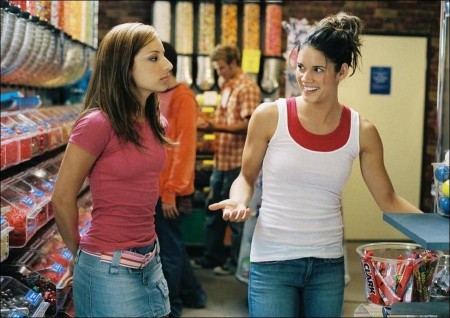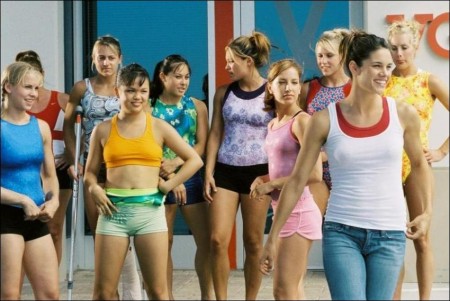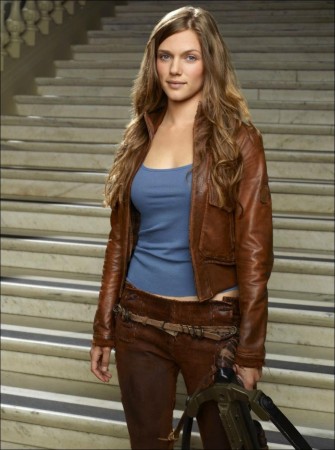Tagline: Defy and Conquer.
The writer of the hit comedy “Bring It On,” takes on the world of competitive gymnastics in “Stick It”. Haley Graham (Missy Peregrym) is a rebellious 17 year-old who is forced to return to the regimented world of gymnastics after a run-in with the law. A judge sentences Haley to her ultimate nightmare — attending an elite gymnastics academy run by legendary hardnosed coach Burt Vickerman (Jeff Bridges).
Haley’s rebellious spirit and quick-witted banter quickly shakes things up at the strict school – making both close friends and bitter foes along the way. Haley surprises herself as she discovers an unexpected ally in the form of her new coach, and learns respect is a two-way street. Haley, Vickerman, and a group of his elite athletes band together to confront a championship and prove that loyalty, friendships and individual athletes matter more than rules.
A Commonality Of Uncommon Women
If there is a universal theme to the work of screenwriter/director Jessica Bendinger, it is that of strong young women seeking to make their way in their world. For Bendinger, this may indeed be a case of art imitating life. A former music journalist with Spin magazine and a writer for “MTV News,” Bendinger was also an acclaimed director of numerous music videos prior to her penning the screenplay for the surprise hit “Bring It On,” starring Kirsten Dunst and set in the not-always-cheerful world of cheerleading. Following that, her screenwriting credits included “The Truth About Charlie,” “First Daughter” and the recent “Aquamarine,” in addition to serving as creative consultant for HBO’s “Sex and the City,” as well as writing an episode.
No matter what landscape her central female characters inhabit (high school cheerleading, globetrotting espionage, Gotham journalism), they all share a similar dynamic: they are strong and individualistic, trying their best to maneuver through life in a maledominated world.
Bendinger observes, “Most of my characters are these gutsy, slightly rebellious girls, who often come smack up against a ceiling of some kind. Let’s face it, if you’re a teenage girl and you aren’t content to ‘go with the flow,’ your options are kind of limited. When you get older, you can make your own way—but that’s not what high school is about. It’s about fitting in. I guess you can say the characters I write about—no matter how old they happen to be—are working toward becoming who they will ultimately be.”
It was this theme of self-realization and her personal involvement with gymnastics that fueled her fire to write not only “Bring It On” (cheerleading is as much about gymnastics as it is about cheering), but also STICK IT. She continues, “When I would watch those [cheerleading] competitions that had such great tumbling and acrobatics to them, I thought it was such a visually appealing world to create a movie in. So when this idea came, I was like, ‘Wow, why not go to the source, to a world I know,’ which is gymnastics. I felt like the timing was right, with the Olympics coming up, and my enthusiasm level was really high. I love the sport, why not? Write what you love. So that’s kind of how it was born—from my life, but also telling this story about a really strong girl set in this sometimes bizarre world.”
Bendinger herself had participated in competitive gymnastics from the time she was nine until she turned 12-years-old, earning a third place state ranking in the floor exercise category. She trained in a Connecticut gym owned by two-time Olympian Muriel Grossfield and was coached by Don Peters, who served as an Olympic coach in 1980. “It was the best you could get, as far as gymnastics training,” Bendinger says. “I went to gymnastics camp, competed, did compulsory routines—it was a big part of my life and I took it very seriously.
It was while she was working on the first draft of “Bring It On” (then entitled “Cheer Fever”) that Bendinger met her future producing partner, Gail Lyon, executive producer of “Peter Pan” and “Stuart Little 2,” co-producer of “Erin Brockovich” and a former executive at Red Wagon Entertainment.
“Jessica and I have a long history,” Lyon says. “I thought ‘Bring It On’ was hysterically funny and authentic and had a great voice. I had just bought an article from The New Yorker that I thought she’d be great for and I hired her as a writer—and we’ve been friends ever since. Though we never worked officially on a project together, we always consulted each other and talked about scripts and her projects. She’d had this idea for a long time to do a movie set in the world of gymnastics. She asked me to get involved and be her producer. And I thought, ‘A movie with Jessica’s great trademark female characters, set in that world, told in her distinctive voice?’ And I immediately said, ‘Absolutely!’”
“Gymnastics is a very weird sport,” Bendinger observes. “Even though it lives in the margins for us, culturally, it’s the top-rated Olympic sport, period. It’s very compelling and upsetting to see such young girls doing such dangerous things, so I think we watch it with a kind of fascination. And I think we watch it at a distance, with a mixture of shock and awe. So one of the things I set out to do while I was writing the script was to allow people to see what a tough sport it is—to take a second look and realize that these girls are as strong, if not stronger than, football players and some of our greatest athletes. And I wanted to show the things that they’re able to do with their bodies, along with their commitment, discipline and the training it takes.”
To further the authenticity of the story, Bendinger, over the course of a few years, meticulously collected print and video clips from all manner of gymnastics events. In October 2004, she edited together a snazzy two-and-a-half-minute compilation of archived gymnastics footage and used it to pitch her project to the studios. The video montage and pitch must have made a strong impression, as a studio bidding war soon followed. Eventually, the project landed at Disney, where Bendinger would make her directorial debut for Touchstone Pictures in partnership with frequent collaborator Spyglass Entertainment.
“I think if you’re going to set a movie in a certain world, it’s important for the story and the characters to be grounded in reality, with details that are organic to that world,” Bendinger says. “So being authentic was really important. I talked to a lot of judges and gymnasts. I was scrupulous about the technical details, because it’s a very confusing, weird sport, with this huge code of points and all these rules that are just bizarre—like an exposed bra strap can get you a uniform deduction, despite the fact that you’re twisting through the air at high speeds. It’s these sorts of rules that Haley really has a problem with, that she questions—and she eventually gets her teammates to question also.
“It’s clear that gymnastics is an incredibly fun, incredibly tough athletic sport, but I think a lot of times, it gets labeled as a poofy girly thing. We hope that people will be awed by the extreme athleticism of these girls and will see the amount of sheer work that goes into it. You cannot argue with the strength and determination of these athletes…most of whom happen to be really young girls. It’s a perfect place for Jessica’s movie,” adds Lyon.
Searching for Haley Graham
While the filmmakers were in the midst of conducting a nationwide search (for gymnasts who could act or actresses who knew gymnastics), Bendinger serendipitously caught an episode of the television program “Life As We Know It”—the show featured an ensemble cast with a young actress named Missy Peregrym among them.
She recalls, “I saw Missy and I was like, ‘Who is that girl?’ I backed up to the credits—thank goodness for TIVO—and I saw her name and looked her up on the internet. I saw she’d been on another show and had a small part in a film. Then, I watched another tape of the show and just thought, ‘That is Haley, that is Haley, that is Haley!’ Missy flew in to read for the part and just naturally embodied it. She was physically very comfortable with herself, and was kind of innocent and sophisticated at the same time. She just had all the right dynamics for the character. She just walked in and was the character. She was Haley.”
Producer Lyon says that from the outset, they knew they wanted a relative unknown. “We scoured actresses, gymnasts, anybody we thought might be able to embody the spirit of this girl,” she says. “It was definitely a tough role to fill—certainly athletically, but also being able to sell the rebellious aspects and still like the character. And when Missy came in, she had so much spark and spirit, she just jumped right out at us.”
As written by Bendinger, Haley Graham had grown up devoting her life to gymnastics until, at the age of 15, a nationally ranked Final Championship hopeful, she walked out in the middle of the prestigious Championships competition; it is during this meet that she discovers a secret that rips apart her family life and, out of despair, she quits the sport…forever. “As a kid sometimes, the weight of the world is so difficult to carry, so to be Haley’s age and to find out that the adults in your life aren’t who they say they are—that really messed her up,” Peregrym explains.
Now, living at home with her newly divorced dad, a Texas real estate developer, and feeling totally despondent, she spends two years bumming around with her two best friends, Poot and Frank, touring around on their dirt bikes and frequently getting into trouble. While attempting to execute a particularly spectacular dare, Haley and her bike crash through an expensive set of glass patio doors (in a home being built in her father’s development)—which is what prompts a local judge to step in and order some kind of rehabilitation. “At this point, Haley is not interested in anything,” Peregrym continues. “She just doesn’t care. She goes back to court—for, like, the millionth time—and gets sent back into gymnastics as part of her sentence for screwing around.”
To make restitution, Haley is shipped off to the VGA—the Vickerman Gymnastics Academy—run by the demanding Burt Vickerman, a longtime coach and former champion who personifies that perfect blend of belligerence and charisma.
“This Isn’t The Real World…This Is MY World.”
In casting the esteemed and award-winning actor Jeff Bridges in the role of Coach Vickerman, first-time feature director Jessica Bendinger says she felt like somebody who’d just gotten a learner’s permit…and was given a Ferrari: “He’s such a legend to me and he was an incredible get for the movie. Jeff brought experience and a really fine-tuned sense of craft. I just think he made Vickerman very realistic and gave him some deep grounding, to where you really believe he is a coach.”
A four-time Academy Award® nominee, Jeff Bridges has headlined in a dizzying variety of acclaimed films—from “The Last Picture Show,” “Starman” and “Jagged Edge” to “The Big Lebowski,” “Seabiscuit” and “The Door in the Floor.”
“When I first learned about the film I said, ‘Oh, great, I get to play a coach in this,’” Bridges recalls. He notes that he has always been a big fan of UCLA’s legendary basketball coach John Wooden, who had coached his brother, fellow actor Beau Bridges, when he was in college. “I thought this was a great opportunity for me to tap into that kind of wonderful character… though it’s not how a coach operates.”
“Vickerman doesn’t know about all the pain, sadness and feelings of betrayal Haley has been carrying around,” says Peregrym. “He just thinks she has this bad attitude for no reason. So initially, Haley’s relationship with Vickerman is very confrontational; she’s very sarcastic and challenging in the beginning, because they’re both testing each other. Haley feels like everybody she ever gets close to lets her down, so being sarcastic and funny is her way of covering up her pain.” If that weren’t enough, the new girl on the block feels that Vickerman, who prizes safety, also plays it safe with the routines he creates for the athletes—too safe, in fact. Eventually, Haley shakes things up by urging the elite team members to start pushing their boundaries, both in their routines and in their lives.
In researching the role, Bridges first met with writer/director Bendinger, who walked him through the world of gymnastics. “I was able to go to one of the Nationals meets with my video camera,” Bridges remembers. “I must have looked rather peculiar there, because there was all this wonderful flipping and tumbling going on and I’m there with my video camera focusing on the coaches, totally turned away from all the action. But I learned a lot that day about how coaches operate. There is a lot of affection—they show encouragement to the athletes—but there is also a kind of toughness that was interesting to observe and which seemed to work for my character.”
“Jeff is so professional, loving, generous, collaborative and patient, that he put everybody at ease immediately,” says Bendinger. “The vibe on the set was fantastic and that was, in large part, due to his generosity.”
“It was interesting because I think Missy and Jeff had a fantastic chemistry even from the outset,” says Lyon. She adds that since Bridges has three daughters of his own in their teens and 20s, he has a natural affinity for being around teenage girls. “He knew the drill, inside and out, because he’d been living with it for a decade.”
As young actors, Peregrym and the others were quickly encouraged by the seasoned pro and came to discover how much fun he was to work with. “Everyone knows that he’s the most likeable, funny guy, and he truly is.” Laughing, Peregrym adds, “And after raising three daughters of his own, he gets it. He understands that we get crazy sometimes. It’s so cool to see somebody that grounded and that down-to-earth after having the career that he’s had.”
The Few, The Proud, The Elites
In addition to her family strife, Haley is driven by the unfairness she perceives in the sport—arbitrary scoring from the judges, the randomness of some of the rules—as well as a rejection of the monotony of repetition and the reliance on safer, cookie-cutter routines. In her own research, Peregrym came to share some of her character’s beliefs.
She explains, “The judges are extremely hard. I’ve been to some competitions where you see these girls completely deflated as soon as they make even the most minor mistake, right after they have completed some insane move. It’s definitely hard for a kid to go through that, and Haley is sick and tired of it. She feels they judge the gymnasts all day long, but that nobody ever judges them. There’s just so much politics involved. So it’s very frustrating when a gymnast doesn’t get the rewards that she feels she deserves.”
So Haley walks into VGA loaded with some valid reasons for disliking the sport. It is ironic, then, that she becomes an object of hatred among some of her peers, who remember her bailing out at the Championships and destroying the Final Championship Gold Medal dreams of her teammate, Tricia Skilken. But some of the younger gymnasts begin to idolize her and her rebellious spirit.
“I love rival stories,” Bendinger enthuses. “I love when you can get those contrasting voices in a scene, it’s just so fun to write.”
Enter Haley’s rival—one of Vickerman’s elites, Joanne, played by Vanessa Lengies, who made a name for herself as one of the stars of the acclaimed NBC series, “American Dreams.” (Haley describes Joanne as a “four-time national competitor. Five-time national Haley hater.”) Lengies was drawn to the film because of the energy of her character and the dynamic between her and the others characters. “Even though I play the ‘witch’ in this movie, you see why she’s that way—you understand her vulnerability, you understand what makes her tick— and that she’s fighting inside and that projects to the outside,” she explains.
“I wanted there to be a villain, but one who wasn’t an obvious villain,” relates Bendinger. “Joanne was a complicated villain to write because she’s the bad guy…but also she’s kind of kooky and misspeaks all the time, even though she thinks she’s really smart and is totally convinced of her own perfection.”
Gail Lyon adds, “I think that Joanne in some ways represents, at least in the beginning of the story, everything that Haley actually dislikes about gymnastics: she’s overly obedient, a poofy girl. But I think Joanne comes to realize, over the course of the story, that Haley really does have something to say about the state of gymnastics and how there’s a world and a life bigger than gymnastics.”
“Joanne is so stuck up,” Lengies states. “Everything has to be perfect in her world—and gymnastics IS her world—she’s never been outside of this little gymnastics bubble. Joanne is a puppet for gymnastics; she’s her mom’s puppet and Vickerman’s puppet—that’s all she knows.
And I think that when Haley comes in she sees her old self in Joanne. Haley wants to get it into Joanne’s head that there’s more to life than gymnastics, and that’s why they have so much friction. Joanne becomes Haley’s case—it’s her project to get Joanne to live a little outside of gymnastics.”
But not everyone at the VGA takes an immediate dislike to Haley. Elites Wei Wei Yong and Mina Hoyt are duly impressed when Haley arrives like a storm and they begin to look up to her, welcoming her differing perspective on the sport and on life. Nikki SooHoo—a 16-year-old newcomer—portrays Wei Wei, the youngest on Vickerman’s chosen squad. “Mina and I are the younger ones in the story and are pretty much the ‘naïve fresh meat,’ as they call it,” SooHoo laughs. “In a way, our characters grow up throughout the story. We learn the ropes through Haley and learn to stand up for ourselves—to stand our ground instead of just always being trampled over and stepped on. I think it’s something that everyone can relate to—finally finding that inner strength that lets you be who you want to be.”
Maddy Curley (the only one of the four lead actresses with prior gymnastics experience) makes her feature film acting debut in as Mina Hoyt. A former college gymnast and seventh grade English teacher in her native North Carolina, Curley says she was a big fan of “Bring It On” and admits that the film inspired her in her audition for STICK IT. “This film has the same competitive spirit and comedy, but at the same time, it’s also very dramatic,” Curley says. “I love how Jessica can pull in the drama to show these huge emotions behind a sport like gymnastics or cheerleading, with the comedy coming from the characters’ relationships and from the youthfulness of Mina and Wei Wei as they’re learning and growing.”
“With Mina and Wei Wei, I wanted characters that would embody the different cliques that you might see in a high school movie,” explains Bendinger. “I love that they are both clueless—only in different ways. Wei Wei’s clueless because she’s young and has been doing gymnastics her whole life and has had no life experience. Since she’s only 16, Nikki brought a natural innocence to her that was wonderful for the part. And Maddy had a lot of gymnastics experience and therefore, a disciplined sophistication. I let her arc become a little more savvy, more mouthy. Since they brought their own special something, I ended up re-writing their parts a bit, basically customizing them for the actors we cast.”
These production notes provided by Touchstone Pictures.
Stick It
Starring: Jeff Bridges, Missy Peregrym, Vanessa Lengies, Nikki SooHoo, Maddy Curley, Tarah Paige
Directed by: Jessica Bendinger
Screenplay: Jessica Bendinger
Release Date: April 28th, 2006
Running Time: 103 minutes
MPAA Rating: PG-13 for some crude remarks.
Studio: Touchstone Pictures
Box Office Totals
Domestic:$26,910,736 (84.2%)
Foreign: $5,066,112 (15.8%)
Total: $31,976,848 (Worldwide)





